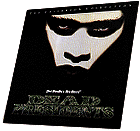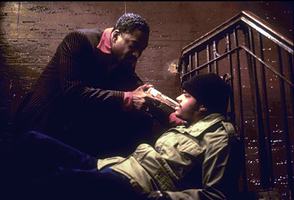

USA drama
1995
color 119 min.
Director: Allen and Albert Hughes
CAV/CLV: $99.95 - available
2 discs, catalog # CC1453L

What should concern not only film critics and reviewers, but all citizens of the
United States in this age of O. J. and Farrakhanıs Million Man March, is the problem of
language and race. We have yet to evolve an appropriate vocabulary that neutralizes the
fictions and attendant mythologies of racialist thought.
In the case of Dead Presidents, if a white reviewer made note of the fact that one
of the film's submotifs involves background imagery of black men eating chicken, some
sensibilities would be offended by the observation, and the reviewer would be attacked as
a racist. Obviously, Allen and Albert like to get with some KFC. So why shouldn't America
in all its ethnic diversity be able to discuss the meaning of a drumstick of fried chicken
in a Hughes brothers film? I'll assume you get the point I'm driving at.
The additional problem in discussing Dead Presidents is its marketing. The film is
saddled by both the hype generated by the on-point brilliance of
Menace II Society and a promotional campaign framing it as an action-crime drama
by individuals who have no inkling of African-American aesthetics. The vocabulary of the
marketplace often undercuts serious critical dialogue in judging aesthetic value.
The Hughes brothers, hip-hop heads that they are, after turning a three-million-dollar
production into a thirty-million-dollar hit, followed their generation's dictum,
the Public Enemy call: DONıT BELIEVE THE HYPE! and resisted pressure to produce a
calculated commercial production. Instead, with Dead Presidents, the Hughes brothers
seized a space for themselves to grow, not only as filmmakers but also as men.
Menace II Society examined the meaning of manhood in South Central Los Angeles by
combining the urgency of rap with the explosive visual power of graffiti, spinning a
visceral tale of ghetto noir: off-the-deep-end Dads squeezing the trigger on
welshing poker pardners with licorice-stick crackheads opening their toothless mouths and
drooling blood while offering to gum the local dopeboys for a piece o' da rock. It was, as
they say, the real shit.
Dead Presidents is based on portions of the book Bloods, a documentary look
at African-American G.I.s in 'Nam (Ari Merretazon's story in particular); and events
inspired by the attempted 1973 holdup of an armored truck by the Black Liberation Army
(the film's character of political conscience is loosely based on exiled revolutionary
Assata Shakur -- no relation to Tupac, though his mother is also a former member of the
Black Panther Party), as well as Merretazon's own attempted robbery. Its title refers to
the worn U.S. currency slated for incineration at the center of the plot.
The story begins in adolescent innocence; but, given as it's the late '60s, that innocence
is shattered by the absurd and grotesque cruelties of war (this absurdity is heightened when
one realizes it's also a movie simulacrum financed by the Disney corporation, staged on a
cattle ranch in Florida). With his humanity numbed and buried by the experience of Vietnam,
Dead Presidents' protagonist returns with a value system wholly out of sync
with early '70s America. His attempts at readjustment are thwarted at every turn;
in the process, he realizes that despite his earnest efforts, the values of a local
pimp who has been supporting the mother of his child prove greater than his own.
In his final descent into a true moral hell, what's left of his humanity rolls out
of his soul in one final roar. Flinging a chair at a black-robed Martin Sheen,
seated behind a judge's bench, the protagonist attacks the very system that created
what he has become. It is a moment that speaks to the frustrations felt by
African-Americans across the generations.
Due to Dead Presidents' Vietnam-era coming-of-age theme, followed by a
descent into a world of crime, the film is a very close cousin to John Woo's
Bullet in the Head. It hits all the conventional points of Western dramatic structure
(one critic, Don Shewey, compared the language of Western drama to sex: foreplay, friction,
squirt, snore); it has the trappings of the crime-action genre; and the visual signifiers
that scream '70s big-afro funk. But the essence of the film is neither crime action drama
nor period protest piece. It is an essay, a cinematic meditation reflecting on the roots of
the generation which sired the rag-eared ghetto dogs of the drive-by '90s. It explores
the motivations of a generation of African-American men who would eventually give birth
to the psycho teens who popped each other off like kernels of Orville Redenbacher's microwaved
corn in Menace II Society. In the final analysis, Dead Presidents is the son
questioning the experience of the father, to deepen his understanding of self.
-- Darius James
Darius James is the author of Negrophobia and
That's Blaxploitation! Roots of the Baadasssss 'Tude.
Credits
Produced and directed by: The Hughes Brothers
Screenplay by: Michael Henry Brown
Story by: Allen & Albert Hughes and Michael Henry Brown
Executive producer: Darryl Porter
Director of photography: Lisa Rinzler
Production designer: David Brisbin
Editor: Dan Lebental
Costume designer: Paul A. Simmons
Co-producer: Michael Bennett
Music by: Danny Elfman
Music supervisor: Bonnie Greenberg
Casting: Risa Bramon Garcia & Mary Vernieu
Transfer
about the transfer
Dead Presidents is presented in its original aspect ratio of 2.35:1.
This digital transfer was created from a 35mm interpositive and the 2 track stereo print master.
Telecine operator: Gregg Garvin/Modern Videofilm, Los Angeles; supervised by the Hughes brothers
and director of photography Lisa Rinzler.
Index of Films


Buy CAV/CLV |
View Items |
Checkout
Ordering Information |
Criterion |
Home Vision
|
|
|




